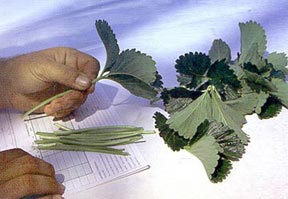Lab results are incredibly useful in hydroponics, as they give us a quantitative view of what’s going on within our crops. From the potential array of analysis that can be carried out, few give us as much information as leaf tissue analysis. Despite this fact, few growers ever routinely carry out this analysis, as it’s often perceived as unnecessary unless problems are showing up within a crop. In this article I want to talk about five different pieces of information that leaf tissue analysis can give us that can be very useful to hydroponic growers, not only when problems are showing up within the plants but as a routine measurement carried out at several different points within a plant’s growing cycle.

Are the plants facing bad vapor pressure deficit (VPD) conditions. Leaf tissue analysis can tell you whether environmental conditions are pushing the plants in the wrong direction by showing you how the ratios of elements like Ca/Mg and Ca/K are skewed. Whenever a flowering plant is grown under a hydroponic solution with a Ca/N close to 1 and the VPD of the environment is very high, the amount of Ca will tend to increase a lot relative to K. This is mainly because the transport of Ca ions is controlled in a bigger proportion by the vapor pressure deficit of the environment, so plants grown at high VPD values will tend to show high Ca in tissue. See this paper, where it is clearly shown how VPD is directly proportional to Ca in tissue. At lower Ca concentrations, the difference tends to be greater between high/low VPD values.

Is there any heavy metal contamination going on. Growing plants for human consumption that contain a significant amount of heavy metals is usually unacceptable. This means that the early detection of heavy metal accumulation is important. Leaf tissue analysis can offer some early insights into heavy metal accumulation within leaves, in order to protect growers from getting end-products that contain large amounts of heavy metals. A plant that contains a significant amount of heavy metals in leaves before the flowering stage is not completely lost, given that heavy metals can be significantly hard to move within plant tissue. If this is detected the problem can be dealt with and inputs can be analyzed to figure out where the heavy metals are coming from. Waiting for the end-product to get a heavy metal test can be a significant waste of valuable time.
Are things where they are supposed to be. One of the reasons why it’s important to carry out leaf tissue analysis routinely is that they can provide you with an idea of whether things are where they are supposed to be or not. Comparing leaf tissue analysis from a plant this crop cycle with plants from past crop cycles can give you an idea about whether things are progressing as planned or whether there are significant deviations from the past. This might be particularly important if changes are being tested or implemented and can provide an early warning about plant stress or issues that have to do with nutrient or environmental inputs.
How nutrients are changing as a function of time. When a plant shows clear visual symptoms of a nutrient deficiency, the problem is already well underway and damage to the crop’s yields have already happened. In order to stay on top of things and make sure the plants are not experiencing any problems, leaf tissue analysis can help us assert whether plants are able to transport all ions adequately. Drops in elemental levels as a function of time in tissue can signal that a problem is imminently going to happen unless the situation is evaluated and measures are taken. Weekly leaf tissue analysis of a crop is a very powerful tool to track nutrient uptake and potential issues, especially if all the data is properly logged and comparisons can be easily drawn. The change in the amount of total solids within leaf tissue can also be tracked and can be used as a way to gauge whether a plant is being exposed to excessively dry conditions.
Are your silicon supplements doing their job. Silicon is very hard to transport by most plants – especially plants like tomatoes and other commercially grown flowering plants – so ensuring that the silicon you provide your plants is reaching tissue becomes important. Potassium silicate applications can often be useless if the are not being done correctly, as the life of silicate in solution is very short once the pH is reduced to the level generally used in hydroponics (5.8-6.2). At this point silicate turns into silicic acid, which readily polymerizes to form insoluble silica chains. Doing leaf tissue analysis looking for silicon generally reveals if the applications of this element are being successful and how successful the assimilation is through the entire crop cycle.
The above are some of the ways in which leaf tissue analysis can help you improve your crop results, although they are by no means the only uses for these quantitative results. In general, leaf tissue analysis should be treated like very valuable information and judicious records of all nutritional and environmental conditions should be kept in association with them. A consistent history of leaf tissue analysis is extremely valuable in a growing facility, it helps avoid problems, carry out effective changes and quantify the real results of experimental interventions.





